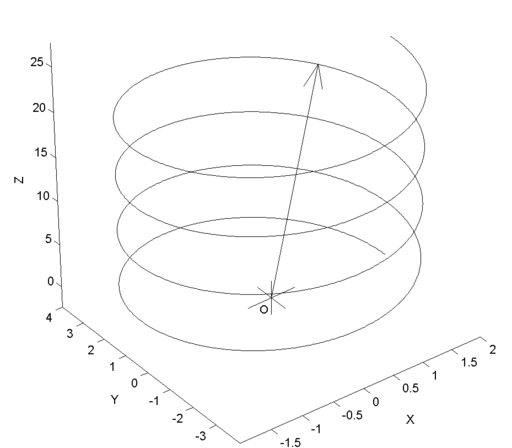Vector-valued functions play an important role in advanced mathematics, particularly in AP® Calculus AB-BC. These functions go beyond simple real-valued input-output pairs by assigning each input a vector as its output. Therefore, mastering the derivative of a vector valued function is crucial for understanding velocity, acceleration, and other phenomena in physics and engineering.
Many methods used for differentiating real-valued functions apply to vector-valued cases. Yet, the main difference is that each vector component is treated like its own function. By reviewing these ideas, students can see exactly how familiar rules (like the power rule or the chain rule) extend to the differentiation of vector valued functions.
What We Review
Understanding Vector-Valued Functions
Definition and Components
A vector-valued function depends on a single parameter, often t, and returns a multi-component output. For instance, one might write:
\displaystyle \mathbf{r}(t)=\langle f(t),g(t),h(t)\rangleEach component, f(t), g(t), or h(t), depends on the same parameter t. This setup resembles parametric from vectors because the parameter describes one or more dimensions of motion or change.
Notation and Review
A typical vector-valued function, \mathbf{r}(t), can be considered as three separate functions combined:
- f(t) in the x-direction
- g(t) in the y-direction
- h(t) in the z-direction

In many problems, h(t) may be absent for two-dimensional motion, but the same principles apply. Whenever a derivative of vector is needed, each component is differentiated separately.
Differentiation of Vector-Valued Functions
Fundamental Differentiation Rules
The process for finding the derivative of vector valued function components mirrors the rules for real functions:
- The derivative of \sin(t) is \cos(t).
- The derivative of t^n is nt^{n-1}.
- The derivative of \ln(t) is \frac{1}{t}, and so on.
To find the derivative of vector valued function \mathbf{r}(t)=\langle f(t),g(t)\rangle, take the derivative of f(t) and g(t) individually. Then, combine them back into a vector.
Step-by-Step Guidelines
- Identify each component function.
- Differentiate each component using standard rules.
- Rewrite the result as a new vector.
These steps simplify the differentiation of vector valued functions by breaking the work into manageable parts.
Example 1: Basic Differentiation of a Two-Component Function
Problem:
Let \mathbf{r}(t)=\langle 2t^2, 3\sin(t)\rangle. Find \mathbf{r}'(t).
Step-by-Step Solution:
- Identify the components:
- f(t)=2t^2
- g(t)=3\sin(t)
- Differentiate each component:
- \frac{d}{dt}\bigl(2t^2\bigr) = 4t
- \frac{d}{dt}\bigl(3\sin(t)\bigr) = 3\cos(t)
- Combine these results into a new vector:
- \mathbf{r}'(t) = \langle4t,3\cos(t)\rangle
Therefore, the derivative of vector \mathbf{r}(t) in this example is \langle 4t,3\cos(t)\rangle.
Physical Interpretation and Applications
The derivative of vector valued function often represents velocity when describing motion. Meanwhile, taking a second derivative indicates acceleration. In physics, \mathbf{r}(t) could represent the position of an object in space, and \mathbf{r}'(t) would show how that position changes over time.
These ideas extend to many real-world contexts. For instance, a car moving along a winding road can be modeled with a two- or three-component system. Its velocity at any instant is the derivative of vector \mathbf{r}(t), and its acceleration is the derivative of \mathbf{r}'(t). Therefore, these concepts connect calculus to physical processes students see every day.
Example 2: Differentiation Using the Chain Rule
Sometimes, each component may involve a nested function. In such cases, the chain rule applies. This means first differentiating the outer function, then multiplying by the derivative of the inner function.
Problem:
Let \mathbf{r}(t) = \langle (t^2 + 1)^3, \cos(5t) \rangle. Find \mathbf{r}'(t) using the chain rule.
Step-by-Step Solution:
- Identify the components:
- f(t) = (t^2 + 1)^3
- g(t) = \cos(5t)
- For f(t), the outer function is u^3 (where u = t^2 + 1), and the inner function is t^2 + 1.
- Derivative of the outer function u^3 is 3u^2.
- Derivative of the inner function t^2+1 is 2t.
- By the chain rule, \frac{d}{dt} \bigl( (t^2+1)^3 \bigr) = 3(t^2+1)^2 \cdot 2t = 6t(t^2+1)^2.
- For g(t), the outer function is \cos(u) (where u = 5t), and the inner function is 5t.
- Derivative of \cos(u) is -\sin(u).
- Derivative of 5t is 5.
- By the chain rule, \frac{d}{dt}\bigl(\cos(5t)\bigr) = -\sin(5t)\cdot 5 = -5\sin(5t).
- Combine these derivatives into a new vector:
- \mathbf{r}'(t)=\langle 6t(t^2+1)^2,-5\sin(5t)\rangle
Quick Reference Chart: Vocabulary and Definitions
| Term | Definition/Explanation |
| Vector-Valued Function | A function whose output consists of multiple components, each usually depending on the same parameter (e.g., t). |
| Derivative of Vector Valued Function | Found by taking the derivative of each component function and recombining into a vector. |
| Parametric From Vectors | A representation of a curve using a parameter; each component is a separate function of that parameter. |
| Chain Rule | A rule for differentiating functions formed by nested functions, applied component-wise for vector-valued inputs. |
Conclusion
When dealing with parametric from vectors, always treat each component function individually. The differentiation of vector valued functions draws on familiar rules taught in real-valued calculus. Even the chain rule works in exactly the same way, only now each component may have its own inner and outer parts. Paying attention to these details ensures a strong understanding of how to find the derivative of vector valued function problems. By applying these guidelines, students are better prepared for real-world physics applications and for success in advanced calculus topics.
Sharpen Your Skills for AP® Calculus AB-BC
Are you preparing for the AP® Calculus exam? We’ve got you covered! Try our review articles designed to help you confidently tackle real-world math problems. You’ll find everything you need to succeed, from quick tips to detailed strategies. Start exploring now!
Need help preparing for your AP® Calculus AB-BC exam?
Albert has hundreds of AP® Calculus AB-BC practice questions, free responses, and an AP® Calculus AB-BC practice test to try out.








